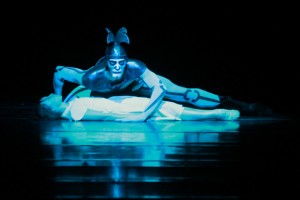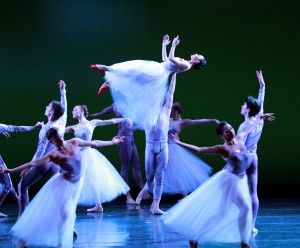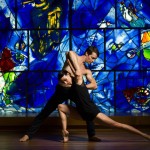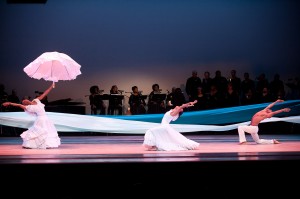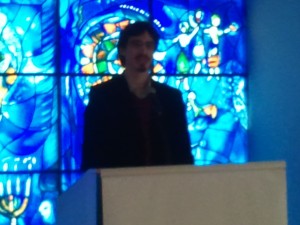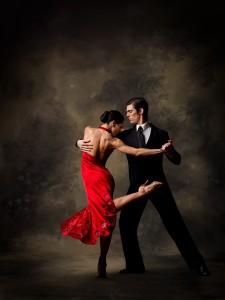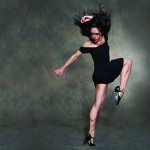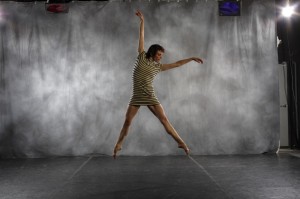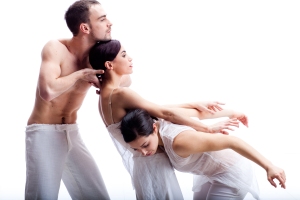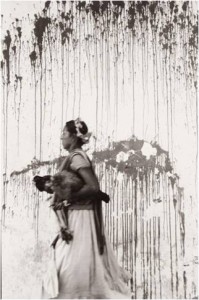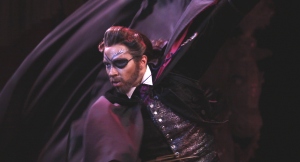
Smith as Drosselmeyer in Joffrey's "Nutcracker". Photo by Herbert Migdoll.
“I’m very thankful,” Michael Smith told me over cocktails this summer. “The Joffrey chapter of my life has been going on for a while. I’m lucky because I never really planned on it being this way.” A Chicago native, he lived for a short time in Gary, Indiana with his teacher/social worker mother before moving back to the city. That is where he got his first taste of dance at school. “My grandma would say that I watched The Nutcracker in her living room and just dance around. She’d say, ‘ok, you need to stop it before you knock something over!'” Smith, now in his 11th season with the Joffrey Ballet, is finishing this year’s run of Nutcracker performances (only two matinees left!). This season he’s dancing multiple parts: a parent in the Party Scene, a soldier, the Mouse King, in snow scene, two parts in Waltz of the Flowers and Russian nougat and Dr. Drosselmeyer, his favorite part. “There’s nothing like it. It’s an acting role, but it really gives you a chance to tell the story with Clara and have a great time with the audience,” says Smith. “You are the storyteller and you get to make all the magic happen. It’s hard because if it’s not done well, the story is lost.”
Here’s my Q&A with a man that literally grew up within the Joffrey and who I’m happy to call friend.
So, what’s your story?
(Laughing) I’m a child of the 80’s. Imagination was really pushed with me and my sister. When I was going to be a freshman in high school, my Mom thought I should audition for this private school…Chicago Academy for the Arts. I wanted to just go to school and be a teenager, but she convinced me. I went to the audition and I got in…then I freaked out. I had no idea what that really meant. Most kids know that they want to dance and have been dancing since they were three. For me, it was more like a hobby. At school. I was taking three hours of ballet, jazz, modern classes and learning about the art form. It wasn’t until my junior year that I thought maybe I should do this…maybe I should start taking this seriously.
How did you go from hobby to Joffrey?
The secretary of the school told me the Joffrey was looking for boys to fill in the background in The Nutcracker and I was like, “no, I don’t do ballet”…but she convinced me. The school sent four of us over and we had to take class. Mr. Arpino came and watched. The asked me and a friend (David Gombert) to come back and take another class, then asked if we were interested in doing Nutcracker. So for a few months, we would go to school in the morning, then head over to Joffrey to take company class at 10:00 am. We were there all day rehearsing. We did Nutcracker season and started getting to know a few people in the company that we weren’t scared of. I was terrified of everyone, but Calvin (Kitten). He’s the cutest little nugget ever. I was a soldier. I still am! I did the same soldier spot for like 12 years. (laughing) That’s sad. Now, I help teach it.
Were you hooked? Was Joffrey it for you?
My goal since my junior year was I want to go to New York. I’m going to dance for Ailey. Period – end of story. My email address used to be Ailey2000! Being at Joffrey…we were in this fantasy bubble where dance was our life for a few months, it was weird transitioning back into school life again. Joffrey was starting a new apprentice program for six dancers and asked if we (Smith and Gombert) were interested. I’d just started taking it seriously, meaning, ok I’m not going to skip my ballet class and go take another modern class. I knew that I didn’t want to go to college. I thought ‘you need something. You can’t be poor!’ I agreed to it and signed the contract. Literally a week later I got offered a contract with Hubbard Street 2 and had to turn it down. I graduated in 200 and started the apprenticeship in the fall.
Over the years, how has the company changed?
Technically, the company has always had its technical people in it, but now it is really emphasized. The company is a lot younger than it used to be. There’s a huge age gap. There’s a small group of us that are about to turn 30 and a few at 25, then the babies…19, 20, 21. Over the years, the emphasis on rep has changed…the things being brought in and what is being demanded of us. I kind of miss doing some of the historic works. There’s nothing better than to be choreographed on, being that vehicle to produce art. At the same time, there’s something very interesting and a lot of growth can happen by doing older, historic works. I go to do the horse in ‘Parade’. Who wants to do that? The experience was amazing. I miss doing Arpino stuff a little. I guess that’s a change as well. I got to dance while he was still alive in his company. To have that greatly influenced how I viewed and still view dance and this company.
Do you have a favorite Mr. A story or memory?
Some of my favorite memories are just random moments. I miss seeing him sitting in front of the room or seeing him in the back giving you a thumbs up or an ‘ok’ sign. As apprentices, we would get gifts from him every once in a while. One of them was this huge, oversized knit scarf that,I assume, someone had made for him. The first couple of years, I only wore it every once in a while, but now it is a saving grace come wintertime. I need that big, chunky scarf. I need Mr. A’s scarf. Getting to dance for him at the opening of the new building (Joffrey Tower), that was a really special moment. He’d always say, ‘This company is going to have a home.” To see him walk into that building was such a special time. His dream just came true. That was pretty kick ass.
How have you changed?
I’m a lot calmer with age. Outside of work, I try to be really chill. In the studio, in my early 20’s, I tried to be a bad ass and talk back. You’re still trying to figure out who you are at that age and my nature was to be more aggressive about it. You have to find where you’re going to put your energy. Life is too short. I’m here to dance. I want to be art. I want to express myself through art. I want to exchange art and discuss it with other people. I’m the most senior boy in the company now and I know what it’s like to be that little punk kid in high school. Now I have all this experience under my belt. There is nothing more humbling than to have someone new in the company and to go and help them. I learn things and help teach it to others. I’ve been here a long time. I’m dedicated to it. It’s home to me.
What have been some of your favorite pieces to perform?
(Jiri) Kylían’s ‘Return to a Strange Land’, hands down. I got to do it with Maia (Wilkins) and Willy (Shives). That was beyond a dream come true on so many levels. Kylían is one of my all-time favorite choreographers. It just feels good to do his movement. Having the chance to dance with two people that are such great partners and to be the third in the trio…that’s a lot to live up to. That was a super highlight. The Pilobulus piece ‘Untitled’, ‘Suite Saint Sans’. ‘Inner Space’ was three dancers in a 4×4 Plexiglass box. Loved it! Everyone wants to go out and be the prince or the lead, but there is something to be gained from doing the more abstract stuff too. Finding your own story in it or how you can get through this to make it entertaining and find growth within yourself. You’ve never had to do some self-examination until you’ve been put in a 4×4 box with two other people for seven minutes! Getting to do one of the stepsisters in ‘Cinderella’ with one of my best friends (Gombert). We were playing ourselves pretty much only in women’s clothing. I don’t know if anything that silly will enter my life again. It was pretty fantastic. And ‘Nutcracker’ is always something special. I do love it. It’s the one time of year where you are performing constantly. It’s like, should I even take this make-up off? I’m going to be right back.
You also have talents in a vast range of hobbies: photography, videography, choreography and teaching. What are your goals?
To take whatever comes and see what happens. When Jessica Lang came and set ‘Crossed’…that was a great experience. Really inspiring. You truly just have to be the vessel and let the art come through you. She told me to never say no to anything. Go do it and see what happens. Try to make all these things happen and see what comes out of it. It was a great piece of advice. Not that you can’t say no, but if you can do it…why not? My goal wold be to keep experiencing everything I can possibly experience. If you allow yourself to be open to just experience it, you’ll learn a lot. I’ve auditioned for Hubbard Street like five or six times now. I love them. I’d love to dance for Hubbard Street.
